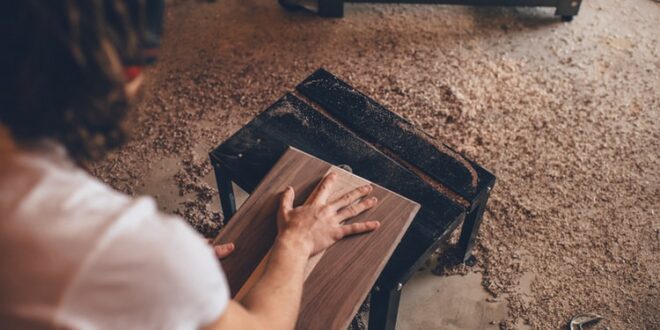Sanding a piece of furniture before painting is necessary to make sure the paint sits on it and does not peel off. Read this article to know how to do it.
When it comes to any project made of wood, sanding is the unsung hero. It does not turn your workpiece like the way cutting it into size does. Neither does it give the wow factor of a rich stain. But it is the central step to be taken while working with raw wood to transform it into an investment piece, one that may add value to your house and lifestyle.
In this article, we are going to share some basic knowledge about how you can sand furniture before painting and a few techniques on how to do it better. So, let’s dive in.
What Is Sanding?
Sanding wood simply means smoothing the surface of wooden furniture, or a chunk of wood that will be used to make furniture. Grains of wood are scraped away in this process so that the surface fiber becomes evenly rough. It is called ‘standing’, but the process has nothing to do with sand. The tools used are called sandpaper and sanders.
Is It Necessary To Sand Furniture Before Painting?
When it comes to sanding furniture, it is better to be safe than sorry. It is preferable to gently sand the surface rather than painting before sanding and then seeing that the paint has peeled off. Preparing furniture for painting simply means you are roughing up the surface lightly so that the paint can stick. If the surface is polished, there won’t be anything for the paint to grab onto. Usually sanding a piece of furniture does not take more than five minutes.
Sanding Grits
Grits are measures of the coarseness of the sandpaper. Sanding grits are grades of sandpaper depending on how many sand granules it has in a square inch. Usually, the fineness of the paper increases with the number of grits.
Sandpapers are picked based on the reasons and needs of the woodworkers. In the case of natural wood, it starts from 40 or 60 and stops at 150 or 180. Medium grits (120 or 150) are beneficial to get rid of old finishing or paints. Fine grits (220 or 240) can be useful for breaking edges like polishing the corner of woodblocks, and before staining or coating. These are used to sand veneers and plywood too. However, the grade required can differ for different kinds of woods.
Now that you know about grits, it’s time to move on to the techniques and tools of sanding. You can sand your furniture in two ways before painting, which are- sanding by hand and sanding with power tools.
Sanding By Hands
When it’s about any project or hobby that requires proper attention to detail, there is no better option than working with hands. You can have the best control over your work when you sand by hand with sandpapers. Besides, it is the least expensive way of sanding.
Cut your sandpaper into four pieces and use them one by one. Or you may fold the paper and use it. But to increase its longevity, make sure the grits do not rub against itself.
You can buy a sanding block and wrap the sandpaper around it. Or you can make your own sanding block by using a little woodblock. If you hold the paper with the three middle fingers of your hand, it will also work as a sanding block. Sanding blocks are mostly required for sharp edges and flat surfaces. They are necessary for applying even pressure. They also prevent the sandpaper from slipping or bunching up.
You should not sand against the wood grain or perpendicular to the grain. Rather, you should sand in the same direction as the grains.
Sanding with Power tools
It is not strictly necessary to use power tools, but it can certainly save you a lot of time and effort.
With the advancement of technology, sanding has also seen many machines and tools. But you require only a few to do all your projects.
-
Random Orbit Sander
This machine is also called rotary sanders. According to Tom Bradly, it is the most useful and versatile sanding machine you can own. Along with spinning, it also moves or vibrates towards a random direction and makes sure there are no circular sanding scratches on the wood surface. This motion is called random orbit. It can cover large surfaces very quickly.
-
Bench top Sanders
These are relatively inexpensive. They come in different combinations and styles. The belt and disk combination one is one of the most useful ones. It is particularly useful for detailed fine works like sanding curved workpieces.
-
Oscillating Spindle Sanders
Basically, it is a drum sander that comes with spindles of various sizes that are easy to switch. It rotates and moves up and down at the same time to make the maximum use of sandpapers and decrease circular scratch patterns and sanding lines in your furniture.
Checking The Progress
You can check the progress with your hands until the furniture surface feels smooth enough, or inspect the furniture from a very low angle, or by wetting the furniture with denatured alcohol like ethanol or paint thinner and examining it into a reflected light from different angles. This will help you to easily notice any imperfections.
Caution
Now you have all the basic ideas on how to sand your furniture before painting. The only thing you need to take care of is your safety. Except for the fine sawdust factors, sanding machines are one of the safest power tools. So to be safe, you should wear a filtered mask, make sure to have good airflow in the workplace and connect a vacuum with the machine.
Happy sanding!
 HammBurg Be informed with latest news, reviews, entertainment, lifestyle tips, and much more.
HammBurg Be informed with latest news, reviews, entertainment, lifestyle tips, and much more.




